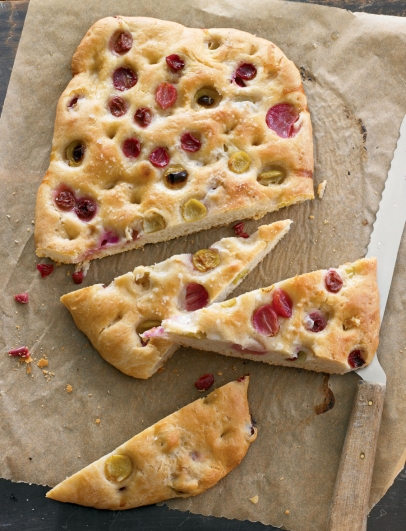Table Grapes
Bounty by the Bunch
A local nursery displayed several wooden boxes filled with sand, table grape canes randomly sticking out, and a sign that said 50 cents each. How could I resist such a bargain? I bought $25 worth and proudly brought them home.
Upon seeing my new purchases, my husband said, “Well, I guess we need an arbor.” He’d grown up in Lafayette, California, among Italian American neighbors, several of whom had grape arbors, which he’d always admired. The elders would sit in their shady arbors in the late summer afternoon, maybe shelling beans or reading their Giornale della Liguria.
He set about building an arbor for our grapes, modeling it on the ones in his old neighborhood. He even went to take photos of a couple that still remained to be sure to get the dimensions right. That was more than 20 years ago, and the grapes have thrived.
A collection of Thompson Seedless is at one end, the Muscats of Alexandria are in the middle and there is a scattering of Ruby Seedless, Flame Seedless and a few dark purple ones whose names I can’t remember.
At first, I was disappointed by the Thompson Seedless. The clusters were large but the grapes—or, more properly, the berries—were very small, not at all like the plump juicy ones I was accustomed to seeing in the supermarket. That’s when I learned that most commercial growers spray on gibberellic acid, a plant growth regulating hormone, to increase bunch and berry size.
I also learned that the grape’s actual name is Sultanina, or Sultana, and that the common name of Thompson Seedless, in this country at least, comes from William Thompson of Marysville, California. In the 1870s, Thompson planted a group of grape cuttings he got from a New York nursery. He propagated the seedless variety and gave some cuttings to his neighbor, John Onstott, who re-propagated the variety and sold millions of cuttings to growers throughout California. They are one of the most versatile of grapes, unfussy to grow, and are suitable for use as table grapes, wine grapes and raisins.
I usually leave a few clusters on the vine, either on purpose or by accident, and they eventually dry and become raisins.
I knew the Muscat grape from having eaten them in France and Italy, and I was delighted to be growing something so exotic in my own backyard. Muscat of Alexandria, grown throughout the Middle East and the Mediterranean, is one of the most ancient of grapes, dating back at least to Cleopatra’s time. The berries are large and honey-gold, sweet and juicy—and have seeds. Like Thompson Seedless, the Muscat is used for table grapes, raisins and wine.
The late Harold Olmo, PhD, a neighbor about 15 miles down the road from us in Winters, was one of the world’s best-known grape breeders. He was also a professor of viticulture at UC Davis, and he created the Ruby Seedless grape from a cross of Muscat of Alexandria with Thompson Seedless and Emperor. The berries are a soft ruby color, sweet but not overly so, and as large as those of Muscat. Olmo is also responsible for creating Red Globe and Perlette, both table grapes, among the more than 30 successful varieties that he bred.
One of my favorite grapes is the Zante currant, or Black Corinth. Like the Muscat of Alexandria, it is an ancient grape and was planted most notably throughout Greece. The berries are very small, magenta colored and sweet with a hint of tartness. They grow in tightly packed clusters. When dried, they are sold as currants, and fresh they are often sold under the name “Champagne grapes.” I’m not sure where that marketing name originated, since they have no connection with the bubbly libation. Perhaps it came about because, like Champagne, they are considered elegant. Fresh, they are a perfect pairing with duck and foie gras, and dried they make a delicious addition to baked goods from scones to tarts and pies.
Grapes seem to be mostly eaten fresh, out of hand, but they can be cooked, as well. I like them roasted in combination with other fruits, seared to accompany meats, and I also use them to make fresh grape pie and focaccia.






